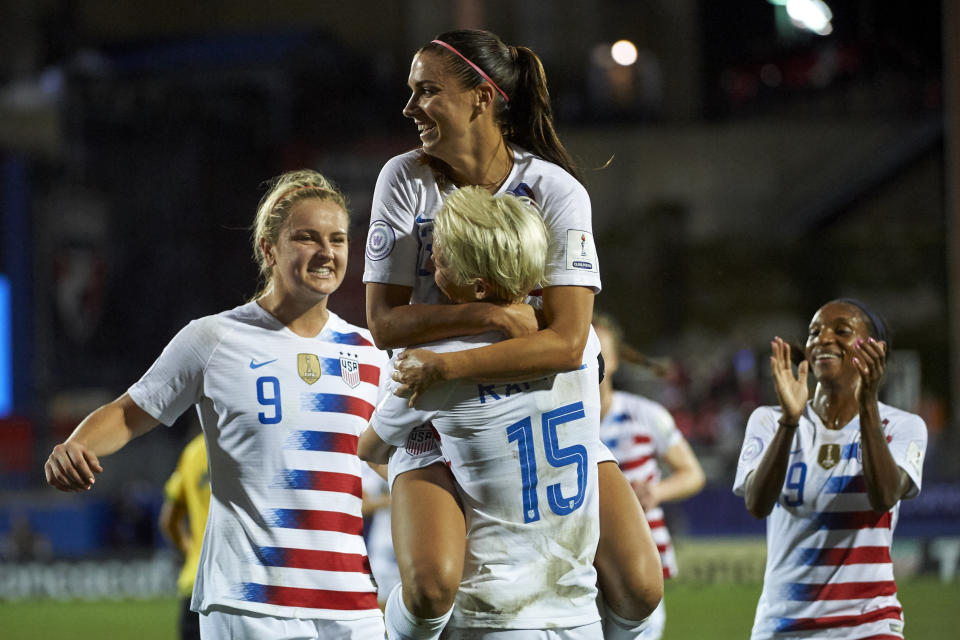United States women's national team clinches World Cup berth by coasting past Jamaica

For the first time in almost four years, a senior American national soccer team qualified for the World Cup on Sunday. The women’s team reached the 2019 Women’s World Cup in France by rolling over Jamaica 6-0, while coasting for the last hour.
It was all predictably simple, as most games are for the defending and record three-time world champions. In a little over half an hour, the Americans were 5-0 ahead. It took less than two minutes for them to get the only goal they would wind up needing, never surrendering a goal or, really, a Jamaican chance.
Following a dead-simple opening goal from Tobin Heath, who finished an inviting rebound, Megan Rapinoe received a laser-guided long ball from Abby Dahlkemper, ran by some defenders and stuck the ball into the near top corner. It was the goal of the night. And with a quarter of an hour gone, the Jamaican resistance was broken.
What a goal!
Megan Rapinoe doubles the USWNT’s lead after a wonderful cross-field pass from Abby Dahlkemper. pic.twitter.com/MhK83vGWeY
— FOX Soccer (@FOXSoccer) October 15, 2018
Julie Ertz, Heath again, and Alex Morgan scored in the span of 12 minutes and then the U.S. took its foot off the gas. A handful of goals would do just fine against the badly overmatched Reggae Girlz. Not until late on did Morgan earn and convert a penalty kick for her second of the game.
And so, by winning the semifinal of the CONCACAF Women’s Championship on a rainy night in Frisco, Texas, the Americans stroll on to France, set to kick off their title defense in early June.
In the group stage, the Yanks had beaten Mexico, Panama and Trinidad and Tobago by a combined score of 18-0. Officially, this Women’s Championship crowns a champion of the region, consisting of North- and Central America and the Caribbean. But really, the point is to figure out which three teams out of the eight will go to the World Cup, and which one gets another chance through a playoff.
Which is to say that, really, the question is who joins the U.S. Such is the gap between the Americans and all their talent and resources, and everybody else. Well, Canada sort of hangs in between the U.S. and the rest of the pack. But since three teams get to go, it doesn’t much matter.
Four years ago, the Americans won all five of their games in this tournament by a 21-0 goal ledger. They might well better that against Canada on Wednesday, since the counter stands at 24 goals scored and none conceded.
The trouble is that none of it really matters. The U.S. women don’t spend a huge part of their year in grueling training camps and playing endless friendlies and glorified exhibition tournaments to win the CONCACAF Championship. And, at any rate, it doesn’t serve as a useful predictor for how the Americans will perform at the World Cup.
There is, in fact, almost no correlation between how the Americans look in qualifying and how they fare at the major tournament that follows.
After crushing everybody in qualifying in 2014, the U.S. ended its 16-year drought and finally won another World Cup in Canada the following summer – albeit after making a very shaky start to the big tournament.
[ Follow Yahoo Soccer on Twitter and Facebook ]
But qualifying for the Olympics the following year, which takes much the same format in CONCACAF, was just as convincing. Five wins from five. Twenty-three goals scored and none allowed. Yet in Rio de Janeiro later that year, the Americans were eliminated in the quarterfinals by Sweden on penalty kicks. That was the team’s worst performance in 13 major tournaments. It was the first time, in fact, that the Americans had failed to medal.
In 2010, the U.S. was stunned by Mexico in the semifinals of World Cup qualifying, after smashing its way to three wins and 18 unanswered goals in qualifying. That meant the Americans had to win a playoff with Italy to make it to Germany, which they scraped through in a pair of 1-0 wins. But once arrived at the Women’s World Cup, the U.S. reached the final and twice took the lead over Japan, before finally losing on penalties.
2002: more American dominance in qualifying, followed by a slog to a 0-3 semifinal dismantling at the hands of Germany in the semifinals at the World Cup on home soil.
No correlation.
Which isn’t to diminish the performance at this tournament. After all, you can only beat the opponents you’re facing, and the U.S. should be encouraged by its form in this tournament. Its team has been largely retooled since the Rio Olympics and moves with a newfound fluidity, masterminded by deep-sitting playmaker Lindsey Horan – the 24-year-old with the magical passes.
But this was all just a formality. A rite of passage. Nothing is proven until the U.S. faces the world’s best in France next summer. For the Americans, getting there isn’t exactly the hard part.
Leander Schaerlaeckens is a Yahoo Sports soccer columnist and a sports communication lecturer at Marist College. Follow him on Twitter @LeanderAlphabet.

